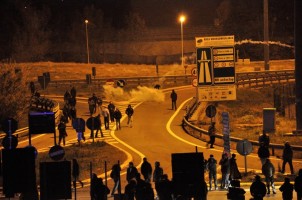
By Lucie Greyl.
It will be almost 20 years since an entire Italian alpine valley started to resist against the development of a new high-speed train line between Lyon and Turin, the so-called TAV. Decades of resistance characterised by the implementation of multistakeholder cooperation and by the application of the postmodern science as citizenship’s tools for developing alternative proposals for the management of their territory; but also decades of useless spending for infinite infrastructural projects that have never been realized.
There is good news from the French border for the No Tav – committee of citizens and local administrations against the Val Di Susa’s High Speed project. On the 5th of November, the French Court of Audit – for the 3rd time this year – expressed in public its perplexities about the High speed project. It evaluates that the cost of the project construction passed from 12 billion Euros – as estimated in 2002 – to 26,1 billion Euros in 2012. Lots of money for Italy, a country in economical recession, knowing that the financial support of the European Union will be minimum[1] and the cost of the Italian part will be major. Moreover, the Court recommends not to exclude the possibility to modernize the existing line. It underlines that the traffic is continuously decreasing while the existing line is under-used and questions past and recent traffic prevision and the real economical opportunity of this project.
For the No Tav movement this late statement not only represents a confirmation of their positions regarding the TAV, but it could change the dynamics behind the French support given to the project. But the declaration of the Court contrasts with the declaration of the Italian Premier Mario Monti after its meeting of the 12th november with the French Prime Minister Jean Marc Ayrault. In that occasion, Monti stated that both parties confirmed their will to continue the project. This meeting will be followed in December by a bilateral meeting in Lyon between the Italian and the French governments. The Italo-French agreement Turin-Lyon high speed line is supposed to be one central question to be discussed. No Tav from France and Italy are organising a counter summit on the 30th of November and the 1st of December to inform and to dialogue with citizens and decision makers on the TAV issues.
In the mean time, the mobilisation of the Susa Valley continues with daily sit- in, assemblies, marches, road blocks and occupations. Convinced of the economical and political opportunity of such a contested project, the Italian technocrat government continues to respond to the citizens of the valley with the militarisation of the territory, while the drills continues to be installed for evaluation soundings. Just yesterday, the hundreds of policemen that were following the transportation of 3 new drills repressed with gas and water the gathering of protesters that was trying to stop the camions. Some might call it another ordinary day of resistance in the valley.
Read CEECEC case studies on the TAV: http://www.ceecec.net/case-studies/high-speed-transport-in-italy/
Sources:
French Court of Audit: http://www.ccomptes.fr/index.php/Actualites/A-la-une/Le-projet-de-liaison-ferroviaire-Lyon-Turin
Greenreport: http://www.greenreport.it/_new/index.php?page=default&id=18772
http://www.presidioeuropa.net/
http://www.pro-natura.it/torino/pdf/150ragioninotavmag2012.pdf


